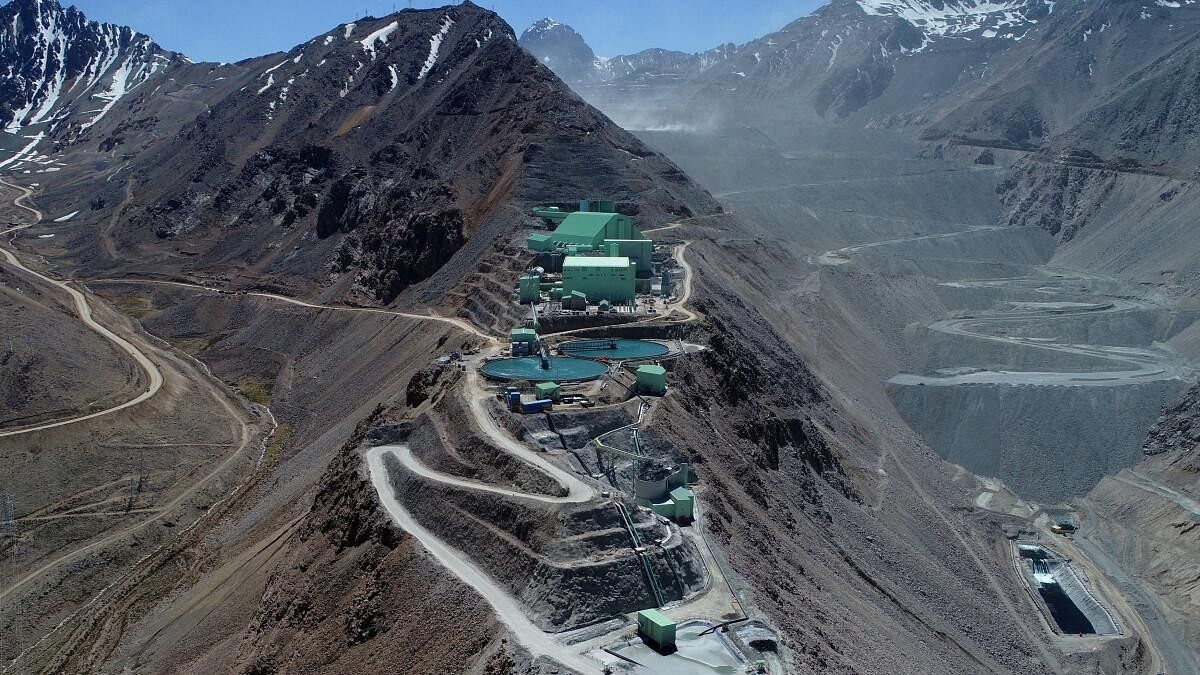
A general view of Anglo American's Los Bronces copper plant in Chile
Credit: Reuters File Photo
By David Fickling
The road to net zero has never been smooth. Especially not when a vital element for decarbonizing the global economy is being hoarded by a group of little-known mining barons.
Copper prices on the London Metal Exchange rose to $11,104.50 a metric ton, their highest level on record, on Monday. Traders are betting the world isn’t producing enough of the conductive metal, which will be vital to link all the wind turbines, motors, cables, and electronic devices needed as the world switches to clean energy. Smelters and refiners produced about 27 million tons last year. An additional 12.8 million tons will need to be supplied in 2030 to keep us on a net-zero path, BloombergNEF wrote this week.
It’s not just futures markets that are moving. The two biggest attempted deals in the global mining sector over the past decade have both been driven by the biggest diggers’ hunger for copper, and the dearth of suitable resources out there. In each case, the suitors have struggled.
Take BHP Group Ltd.’s $49 billion bid for Anglo American Plc, extended for a week on Wednesday after the target rejected an initial offer. Anglo, built up through founder Ernest Oppenheimer’s control of the global diamond trade in the early 20th century, is a potluck of good and bad businesses these days that many bidders have shied away from. The prize for BHP is a rare opportunity to build its position in copper through shares in two world-beating Chilean copper mines: Collahuasi and Los Bronces.
It’s the same story with Glencore Plc’s $27 billion plan last year to buy Teck Resources Ltd. The deal would have given Glencore stakes in two of the best copper pits to create the world’s third-biggest miner of the metal. It was blocked by Norman Keevil, the 86-year-old son of the company’s founder, who still controls the business via a dual-class share structure. Glencore ended up settling for a $6.9 billion purchase of Teck’s steelmaking coal assets instead.
It’s pattern we’re likely to see again, thanks to the way just four families have gained influence over some of the world’s richest mineral deposits. Companies controlled by the Keevil, Larrea, Luksic, and Lundin dynasties together produce close to one-tenth of all mined copper. The families’ combined net worth is some $82 billion, according to data compiled by Bloomberg. Despite that wealth, their firms suffer from relatively high capital costs, making it harder for them to invest as aggressively as booming demand might dictate.
In Mexico, Germán Larrea has built up an impregnable copper empire on either side of the border with Arizona, based in part on assets developed a century ago by the Guggenheim family and on Buenavista, a storied pit where labor clashes helped spark the Mexican revolution in 1910. Through his control of Grupo Mexico SAB de CV, the publicity-shy Larrea has built a $42 billion fortune, the country’s second-largest.
Further south in Chile, the country’s richest woman Iris Fontbona and her sons Jean-Paul Luksic and Andrónico Luksic Craig control Antofagasta Plc, the crown jewel of a sprawling conglomerate founded by Fontbona’s husband Andrónico Luksic that rose, and fell, and rose again through Chile’s tumultuous postwar years.
Swedish oil prospector Adolf Lundin was a comparable success story — first discovering Qatar’s gas fields before his family companies finally broke into the Andes in 2014. Nemesia Sarl, a Luxembourg-based company that controls the Lundin family assets, has holdings of about $5.4 billion in listed businesses, according to data compiled by Bloomberg.
The most modest of the group is probably Keevil, whose father parlayed a copper discovery near his northern Ontario holiday home into a series of investments that eventually became Teck. Family holdings in the Class A stock are worth about $293 million, and will lose their 60% control over voting rights when the share structure is unwound in 2029.
It’s tempting to say it doesn’t matter who controls the world’s copper. But that’s not quite right. Investors demand higher returns from illiquid businesses with dominant shareholders, and that raises their cost of capital — ultimately lifting the bar that potential mining projects have to clear before they’re considered profitable. That’s deterring the investment that the energy transition desperately needs.
Mining is a speculative activity that’s not so very different from venture capital or film production. The creative heart of the business lies in the small-scale explorers who still account for nearly two-thirds of mineral discoveries. For the whole industry to work, there needs to be a clear path for those deposits to be developed by progressively bigger miners who can take advantage of greater and greater economies of scale, cost and finance. The barons’ hold on some of the world’s best pits is blocking that road to riches.
You don’t have to watch Succession to know that dynastic wealth rarely breeds happiness for its heirs. There’s a lesson in that. This generation’s mining tycoons would do well to follow the example of the Oppenheimers, the Guggenheims and the Roys, and exchange their power over this one element for cold, hard cash.
You only need to look at the surging prices on futures markets to know that investors desperately want the chance to develop the metal the energy transition needs. It’s time the copper barons gave them that opportunity.